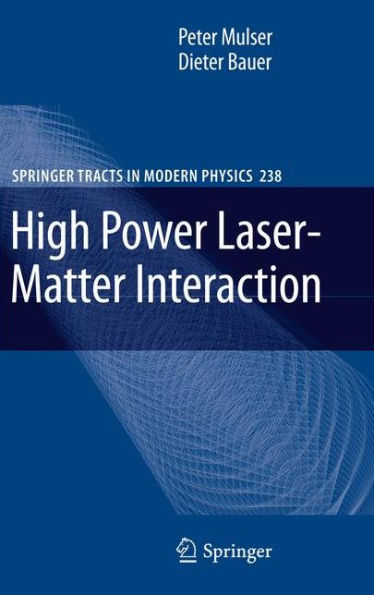High Power Laser-Matter Interaction / Edition 1 available in Hardcover

High Power Laser-Matter Interaction / Edition 1
- ISBN-10:
- 3540506691
- ISBN-13:
- 9783540506690
- Pub. Date:
- 07/31/1905
- Publisher:
- Springer Berlin Heidelberg
- ISBN-10:
- 3540506691
- ISBN-13:
- 9783540506690
- Pub. Date:
- 07/31/1905
- Publisher:
- Springer Berlin Heidelberg

High Power Laser-Matter Interaction / Edition 1
Hardcover
Buy New
$249.99Overview

Product Details
| ISBN-13: | 9783540506690 |
|---|---|
| Publisher: | Springer Berlin Heidelberg |
| Publication date: | 07/31/1905 |
| Series: | Springer Tracts in Modern Physics , #238 |
| Edition description: | 2010 |
| Pages: | 416 |
| Product dimensions: | 6.10(w) x 9.25(h) x 0.04(d) |
Table of Contents
1 Introductory Remarks and Overview 1
2 The Laser Plasma: Basic Phenomena and Laws 5
2.1 Laser-Particle Interaction and Plasma Formation 6
2.1.1 High-Power Laser Fields 6
2.1.2 Single Free Electron in the Laser Field (Nonrelativistic) 9
2.1.3 Collisional Ionization, Plasma Heating, and Quasineutrality 13
2.2 Fluid Description of a Plasma 24
2.2.1 Two-Fluid and One-Fluid Models 24
2.2.2 Linearized Motions 37
2.2.3 Similarity Solutions 44
2.3 Laser Plasma Dynamics 58
2.3.1 Plasma Production with Intense Short Pulses 60
2.3.2 Heating with Long Pulses of Constant Intensity 63
2.3.3 Similarity Considerations 69
2.4 Steady State Ablation 74
2.4.1 The Critical Mach Number in a Stationary Planar Flow 75
2.4.2 Ablative Laser Intensity 78
2.4.3 Ablation Pressure in the Absence of Profile Steepening 82
References 85
3 Laser Light Propagation and Collisional Absorption 91
3.1 The Optical Approximation 92
3.1.1 Ray Equations 93
3.1.2 WKB Approximation 98
3.1.3 Energy Fluxes 101
3.2 Stokes Equation and its Applications 107
3.2.1 Homogeneous Stokes Equation 107
3.2.2 Reflection-Free Density Profiles 112
3.2.3 Collisional Absorption in Special Density Profiles 113
3.2.4 Inhomogeneous Stokes Equation 115
3.3 Collisional Absorption 118
3.3.1 Collision Frequency of Electrons Drifting at Constant Speed (Oscillator Model) 120
3.3.2 Thermal Electrons in a Strong Laser Field 129
3.3.3 The Ballistic Model 134
3.3.4 Equivalence of Models 142
3.3.5 Complementary Remarks 143
3.4 Inverse Bremsstrahlung Absorption 146
3.5 Ion Beam Stopping 149
References 150
4 Resonance Absorption 153
4.1 Linear Resonance Absorption 154
4.1.1 The Capacitor Model 159
4.1.2 Steep Density Gradients and Fresnel Formula 160
4.1.3 Comparison with Experiments 163
4.2 Nonlinear Resonance Absorption 164
4.2.1 High Amplitude Electron Plasma Waves at Moderate Density Gradients 165
4.2.2 Resonance Absorption by Nonlinear Electron Plasma Waves 168
4.3 Hot Electron Generation 172
4.3.1 Acceleration of Electrons by an Intense Smooth Langmuir Wave 173
4.3.2 Particle Acceleration by a Discontinuous Langmuir Wave 178
4.3.3 Vlasov Simulations and Experiments 179
4.4 Wavebreaking 182
4.4.1 Hydrodynamic Wavebreaking 184
4.4.2 Kinetic Theory of Wavebreaking 186
References 191
5 The Ponderomotive Force and Nonresonant Effects 193
5.1 Ponderomotive Force on a Single Particle 194
5.1.1 Conservation of the Cycle-Averaged Energy 195
5.1.2 The Standard Perturbative Derivation of the Force 199
5.1.3 Rigorous Relativistic Treatment 201
5.2 Collective Ponderomotive Force Density 206
5.2.1 Bulk Force 206
5.2.2 The Force Originating from Induced Fluctuations 206
5.2.3 Global Momentum Conservation 209
5.3 Nonresonant Ponderomotive Effects 210
5.3.1 Ablation Pressure 211
5.3.2 Filamentation and Self-Focusing 219
5.3.3 Modulational Instability 222
References 225
6 Resonant Ponderomotive Effects 229
6.1 Tools 229
6.1.1 Waves, Energy Densities and Wave Pressure 230
6.1.2 Doppler Shifts 232
6.2 Instabilities Driven by Wave Pressure 238
6.2.1 Resonant Ponderomotive Coupling 238
6.2.2 Unstable Configurations 242
6.2.3 Growth Rates 245
6.3 Parametric Amplification of Pulses 256
6.3.1 Slowly Varying Amplitudes 257
6.3.2 Quasi-Particle Conservation and Manley-Rowe Relations 258
6.3.3 Light Scattering at Relativistic Intensities 259
References 265
7 Intense Laser-Atom Interaction 267
7.1 Atomic Units 267
7.2 Atoms in Strong Static Electric Fields 270
7.2.1 Separation of the Schrödinger Equation 272
7.2.2 Tunneling Ionization 277
7.3 Atoms in Strong Laser Fields 281
7.3.1 Floquet Theory and Dressed States 283
7.3.2 Non-Hermitian Floquet Theory 287
7.3.3 Stabilization 288
7.3.4 Strong Field Approximation 292
7.3.5 Few-Cycle Above-Threshold Ionization 301
7.3.6 Simple Man's Theory 304
7.3.7 Interference Effects 306
7.3.8 High-Order Harmonic Generation 308
7.3.9 Strong Field Approximation for High-Order Harmonic Generation: the Lewenstein Model 313
7.3.10 Harmonic Generation Selection Rules 315
7.4 Strong Laser-Atom Interaction Beyond the Single Active Electron 319
7.4.1 Nonsequential Ionization 320
References 326
8 Relativistic Laser-Plasma Interaction 331
8.1 Essential Relativity 331
8.1.1 Four Vectors 331
8.1.2 Momentum and Kinetic Energy 336
8.1.3 Scalars, Contravariant and Covariant Quantities 337
8.1.4 Ideal Fluid Dynamics 340
8.1.5 Kinetic Theory 341
8.1.6 Center of Momentum and Mass Frame of Noninteracting Particles 343
8.1.7 Moment Equations 344
8.1.8 Covariant Electrodynamics 348
8.2 Particle Acceleration in an Intense Laser Field 351
8.2.1 Particle Acceleration in Vacuum 353
8.2.2 Wakefield and Bubble Acceleration 359
8.3 Collisionless Absorption in Overdense Matter and Clusters 363
8.3.1 Computer Simulations of Collisionless Laser-Target Interaction 364
8.3.2 Search for Collisionless Absorption 371
8.3.3 Collisionless Absorption by Anharmonic Resonance 378
8.4 Some Relativity of Relevance in Practice 392
8.4.1 Overview 392
8.4.2 Critical Density Increase for Fast Ignition 393
8.4.3 Relativistic Self-Focusing 400
References 401
Index 405
